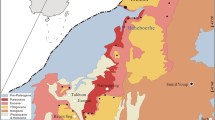Abstract
The problematic Tapinocephalus Assemblage Zone (AZ) theriodont Eriphostoma microdon Broom, 1911 is redescribed based on computed tomographic images of the type and only known specimen. Eriphostoma is identified as a gorgonopsian, one of the few representatives of this clade known from the Middle Permian. Eriphostoma microdon represents a valid taxon diagnosed by the combination of elongate delta-shaped palatine bosses with numerous small teeth and a short, downward-sloping snout. Among gorgonopsians, Eriphostoma is most similar to Gorgonops torvus, but can be distinguished from that taxon by a trough separating the palatal bosses, relatively larger fossa for the lower canine, relatively shorter, taller snout, and mediolaterally thinner premaxilla at its posterior alveolar margin. Other nominal gorgonopsian taxa from the Tapinocephalus AZ exhibit the same general cranial morphology as Eriphostoma, suggesting that most are synonymous. Additional preparation and study of these other taxa will be necessary before their synonymy can be confirmed, however.
Access this chapter
Tax calculation will be finalised at checkout
Purchases are for personal use only
Similar content being viewed by others
References
Abdala, F., Rubidge, B. S., & van den Heever, J. (2008). The oldest therocephalians (Therapsida, Eutheriodontia) and the early diversification of Therapsida. Palaeontology, 51, 1011–1024.
Angielczyk, K. D., & Sullivan, C. (2008). Diictodon feliceps (Owen, 1876), a dicynodont (Therapsida, Anomodontia) species with a Pangaean distribution. Journal of Vertebrate Paleontology, 28, 788–802.
Angielczyk, K. D., Fröbisch, J., & Smith, R. M. H. (2005). On the stratigraphic range of the dicynodont taxon Emydops (Therapsida: Anomodontia) in the Karoo Basin, South Africa. Palaeontologia Africana, 41, 23–33.
Bonaparte, C. L. (1846). Catalogo metodico dei pesci europei. Atti della Settima Adunanza degli Scienziati Italiani, Napoli, Pt., 2, 1–95.
Boonstra, L. D. (1934). Additions to our knowledge of the South African Gorgonopsia, preserved in the British Museum (Natural History). Annals of the South African Museum, 31, 175–213.
Boonstra, L. D. (1935). On the South African gorgonopsian reptiles preserved in the American Museum of Natural History. American Museum Novitates, 772, 1–14.
Boonstra, L. D. (1953). A report on a collection of fossil reptilian bones from Tanganyika Territory. Annals of the South African Museum, 42, 5–18.
Boonstra, L. D. (1963). Early dichotomies in the therapsids. South African Journal of Science, 54, 176–195.
Boonstra, L. D. (1969). The fauna of the Tapinocephalus Zone (Beaufort beds of the Karoo). Annals of the South African Museum, 56, 1–73.
Broili, F., & Schröder, J. (1934). Beobachtungen an Wirbieltieren der Karrooformation. IV. Ein neuer Gorgonopside aus den unteren Beaufort-Schichten. Sitzungsberichte der mathematisch-naturwissenschaftlichen Abteilung der Bayerischen Akademie der Wissenschaften zu München, 1934, 209–223.
Broili, F., & Schröder, J. (1935). Über die Skelettrests eines Gorgonopsiers aus den unteren Beaufort-Schichten. Sitzungsberichte der mathematisch-naturwissenschaftlichen Abteilung der Bayerischen Akademie der Wissenschaften zu München, 1935, 279–330.
Broom, R. (1911). On some new South African Permian reptiles. Proceedings of the Zoological Society of London, 1911, 1073–1082.
Broom, R. (1913). On four new fossil reptiles from the Beaufort series, South Africa. Records of the Albany Museum, 2, 397–401.
Broom, R. (1915a). On some new carnivorous therapsids in the collection of the British Museum. Proceedings of the Zoological Society of London, 1915, 163–173.
Broom, R. (1915b). Catalogue of types and figured specimens of fossil vertebrates in the American Museum of Natural History. II. Permian, Triassic and Jurassic reptiles of South Africa. Bulletin of the American Museum of Natural History, 25, 105–164.
Broom, R. (1930). On the structure of the mammal-like reptiles of the sub-order Gorgonopsia. Philosophical Transactions of the Royal Society of London B, 218, 345–371.
Broom, R. (1932). The mammal-like reptiles of South Africa and the origin of mammals. London: H. F. & G. Witherby.
Broom, R. (1935). On some new genera and species of Karroo fossil reptiles. Annals of the Transvaal Museum, 18, 55–72.
Broom, R. (1940). Some new Karroo reptiles from the Graaff-Reinet District. Annals of the Transvaal Museum, 20, 71–87.
Colbert, E. H. (1948). The mammal-like reptile Lycaenops. Bulletin of the American Museum of Natural History, 89, 353–404.
Gebauer, E. V. I. (2007). Phylogeny and evolution of the Gorgonopsia with a special reference to the skull and skeleton of GPIT/RE/7113 (‘Aelurognathus’ parringtoni). Unpublished Ph.D. thesis, Eberhard-Karls Universität Tübingen.
Gebauer, E. V. I. (2013). Re-assessment of the taxonomic position of the specimen GPIT/RE/7113 (Sauroctonus parringtoni comb. nov., Gorgonopsia). In C. F. Kammerer, K. D. Angielczyk, & J. Fröbisch (Eds.), Early evolutionary history of the Synapsida (pp. 185–207). Dordrecht: Springer.
Haughton, S. H. (1915). Investigations in South African fossil reptiles and Amphibia. 7. On some new Gorgonopsians. Annals of the South African Museum, 12, 82–90.
Haughton, S. H. (1924a). A bibliographic list of pre-Stormberg Karroo Reptilia, with a table of horizons. Transactions of the Royal Society of South Africa, 12, 51–104.
Haughton, S. H. (1924b). Investigations in South African fossil reptiles and Amphibia. 12. On some Gorgonopsian skulls in the collection of the South African Museum. Annals of the South African Museum, 12, 499–517.
Haughton, S. H. (1929). On some new therapsid genera. Annals of the South African Museum, 28, 55–78.
Haughton, S. H., & Brink, A. S. (1954). A bibliographical list of Reptilia from the Karroo beds of Africa. Palaeontologia Africana, 2, 1–187.
Hopson, J. A., & Kitching, J. W. (1972). A revised classification of cynodonts (Reptilia; Therapsida). Palaeontologia Africana, 14, 71–85.
Huene, F. von. (1950). Die Theriodontier des ostafrikanischen Ruhuhu-Gebietes in der Tübinger Sammlung. Neues Jahrbuch für Geologie und Paläontologie Abhandlungen, 92, 47–136.
Ivakhnenko, M. F. (2008). Cranial morphology and evolution of Permian Dinomorpha (Eotherapsida) of Eastern Europe. Paleontological Journal, 42, 859–995.
Joleaud, M. L. (1920). Rectifications de nomenclature. Revue Critique de Paléozoologie et de Paléophytologie, 24, 36.
Kammerer, C. F. (2011). Systematics of the Anteosauria (Therapsida: Dinocephalia). Journal of Systematic Palaeontology, 9, 1–44.
Kammerer, C. F., Angielczyk, K. D., & Fröbisch, J. (2011). A comprehensive taxonomic revision of Dicynodon (Therapsida, Anomodontia) and its implications for dicynodont phylogeny, biogeography, and biostratigraphy. Society of Vertebrate Paleontology Memoir, 11, 1–158.
Kemp, T. S. (1969). On the functional morphology of the gorgonopsid skull. Philosophical Transactions of the Royal Society of London Series B Biological Sciences, 256, 1–83.
Kemp, T. S. (2005). The origin and evolution of mammals. Oxford: Oxford University Press.
King, G. M., & Rubidge, B. S. (1993). A taxonomic revision of small dicynodonts with postcanine teeth. Zoological Journal of the Linnean Society, 107, 131–154.
Kitching, J. W. (1977). The distribution of the Karroo vertebrate fauna. Bernard Price Institute for Palaeontological Research Memoir No. 1, 1–131.
Laurin, M. (1998). New data on the cranial anatomy of Lycaenops (Synapsida, Gorgonopsidae), and reflections on the possible presence of streptostyly in gorgonopsians. Journal of Vertebrate Paleontology, 18, 765–776.
Liu, J., Rubidge, B., & Li, J. (2010). A new specimen of Biseridens qilianicus indicates its phylogenetic position as the most basal anomodont. Proceedings of the Royal Society of London B, 277, 285–292.
Lydekker, R. (1890). Catalogue of the Fossil Reptilia and Amphibia in the British museum (Natural History). Part IV. Containing the orders Anomodontia, Ecaudata, Caudata, and Labyrinthodontia; and supplement. London: Trustees of the British Museum (Natural History).
Owen, R. (1881). On the Order Theriodontia, with a description of a new genus and species (Ælurosaurus felinus, Ow.). Quarterly Journal of the Geological Society of London, 37, 261–265.
Pravoslavlev, P. A. (1927). Gorgonopsidae from the North Dvina Expedition of V. P. Amalitzki. Severo-Dvinskie raskopki Prof. V. P. Amalitskogo, 3, 1–117 [in Russian].
Ray, S., & Bandyopadhyay, S. (2003). Late Permian vertebrate community of the Pranhita-Godavari valley, India. Journal of Asian Earth Sciences, 21, 643–654.
Rubidge, B. S. (Ed.) (1995). Biostratigraphy of the Beaufort Group (Karoo Supergroup). South African Committee for Stratigraphy Biostratigraphic Series No. 1, 1–46.
Sigogneau, D. (1970). Révision systématique des Gorgonopsiens sud-africains. Cahiers de Paléontologie. Paris: Centre National de la Recherche Scientifique.
Sigogneau-Russell, D. (1989). Theriodontia I. In P. Wellnhofer (Ed.), Handbuch der Paläoherpetologie (Vol. 17 B/I). Stuttgart: Gustav Fischer Verlag.
Smiley, T. M., Sidor, C. A., Maga, A., & Ide, O. (2008). The vertebrate fauna of the upper Permian of Niger. VI. First evidence of a gorgonopsian therapsid. Journal of Vertebrate Paleontology, 28, 543–547.
van den Heever, J. A. (1987). The comparative and functional cranial morphology of the early Therocephalia (Amniota: Therapsida). Unpublished Ph.D. thesis, University of Stellenbosch.
van den Heever, J. A. (1994). The cranial anatomy of the early Therocephalia (Amniota: Therapsida). Universiteit van Stellenbosch Annale, 1994, 1–59.
Watson, D. M. S., & Romer, A. S. (1956). A classification of therapsid reptiles. Bulletin of the Museum of Comparative Zoology, 114, 35–89.
Wyllie, A. (2003). A review of Robert Broom’s therapsid holotypes: Have they survived the test of time? Palaeontologia Africana, 39, 1–19.
Acknowledgments
Special thanks are due to Matt Frenkel and Becky Rudolph of the Microscopy and Imaging Facility at the AMNH for their aid in the scanning of this specimen. Thanks are also due to the following curators and collection managers for permission to study the gorgonopsian specimens in their care: Billy DeKlerk (Albany Museum, Grahamstown), Carl Mehling (American Museum of Natural History, New York), Paul Barrett and Sandra Chapman (Natural History Museum, London), Bruce Rubidge, Michael Raath, and Fernando Abdala (Bernard Price Institute, Johannesburg), Johann Neveling and Ellen de Kock (Council for Geosciences, Pretoria), Bill Simpson (Field Museum of Natural History, Chicago), Jennifer Botha-Brink and Elize Butler (National Museum, Bloemfontein), Andrey Kurkin and Mikhail Ivakhnenko (Paleontological Institute, Moscow), Sheena Kaal (Iziko, the South African Museum, Cape Town), Stephany Potze (Ditsong, Pretoria), Pat Holroyd (University of California Museum of Paleontology, Berkeley), and Matt Carrano (National Museum of Natural History, Washington, DC). Tom Kemp, Eva Gebauer, and Christian Sidor are thanked for their helpful reviews of the original manuscript.
Author information
Authors and Affiliations
Corresponding author
Editor information
Editors and Affiliations
Rights and permissions
Copyright information
© 2014 Springer Science+Business Media Dordrecht
About this chapter
Cite this chapter
Kammerer, C.F. (2014). A Redescription of Eriphostoma microdon Broom, 1911 (Therapsida, Gorgonopsia) from the Tapinocephalus Assemblage Zone of South Africa and a Review of Middle Permian Gorgonopsians. In: Kammerer, C., Angielczyk, K., Fröbisch, J. (eds) Early Evolutionary History of the Synapsida. Vertebrate Paleobiology and Paleoanthropology. Springer, Dordrecht. https://doi.org/10.1007/978-94-007-6841-3_11
Download citation
DOI: https://doi.org/10.1007/978-94-007-6841-3_11
Published:
Publisher Name: Springer, Dordrecht
Print ISBN: 978-94-007-6840-6
Online ISBN: 978-94-007-6841-3
eBook Packages: Earth and Environmental ScienceEarth and Environmental Science (R0)





